Revealing the Impact of Postcards: Why Smart Marketers Are Mailing More in 2025

By Rachel Horowitz | November 17th, 2025 | Direct Mail, Blog
The postcard is not old-fashioned — it’s efficient, measurable, and more persuasive than most people realize. In an era of inbox fatigue and ad-blocked displays, a simple, well-targeted postcard breaks through. Below I’ll explain why postcards work, share up-to-date stats that prove it, and give practical steps to build a high-performing postcard campaign.
Postcards: the concise, tactile advantage
Postcards force you to be brief, bold, and benefit-driven. They arrive in a physical mailbox where recipients give them undivided attention. Studies and industry reports show direct mail—especially short, visual formats like postcards—still wins attention and conversions in ways digital channels struggle to match. For example, many sources report that direct mail open/engagement rates and ROI are substantially higher than typical email metrics.
Numbers that matter (recent, sourced facts)
- Postcards deliver meaningful response rates. Depending on the dataset and year, postcard response rates are commonly reported in the ~2.8%–4.0% range, often higher than many digital channels. (Different formats and audiences shift the figure.)
- Direct mail ROI is strong. Multiple industry round-ups show direct mail returns ranging from about $4 to $12 for every $1 spent in many use cases, and many brands report direct mail outperforming other channels on ROI.
- Personalization works. Marketers report that personalization significantly boosts direct-mail response (88% of marketers say personalized direct mail improves response rates), and tactics like PURLs, personalized offers, and variable printing raise effectiveness.
- Integrating channels multiplies outcomes. Combining postcards with digital touches—email, SMS reminders, or personalized landing pages—can boost overall campaign response rates substantially (reports show integrated tactics can lift combined response by double-digits or more).
- Postage and unit-cost ranges are reasonable for targeting. Bulk postcard postage is economical for targeted campaigns; real-world per-piece costs vary by class, volume, and size (First-Class postcards cost more but deliver faster; bulk presort options lower unit costs). Expect to model anywhere from ~$0.40–$1.20 per piece depending on service and quantity.
Why postcards specifically?
- Low friction for recipients. No envelope to open, no login required — a glance often does the job.
- High creative impact in small real estate. The compact canvas forces clarity: headline, visual, single strong CTA.
- Fast production and iterative testing. Postcards are cheaper and faster to print and mail than many complex direct-mail packages — great for A/B tests.
- Easy to track. Use trackable codes (PURLs, unique promo codes, QR codes) to tie offline touches to online conversions.
- Habit & memory benefits. Physical mail is revisited; people keep and show postcards more often than one might expect, extending your message life.
Building a postcard campaign that converts
Follow this five-step blueprint:
1. Define a tight audience.
Target by hyper-local geography, recent website behavior, purchase recency, or lookalike modeling. The tighter the list, the higher the response—and the lower your wasted postage.
2. Lead with a single, clear offer.
Postcards must prioritize one measurable CTA: “Claim 20% off with code POST24” or “Scan QR for a free quote.” Too many CTAs dilute response.
3. Personalize where it counts.
Use variable fields (first name, neighborhood-specific hook, recent purchase reminder), a PURL or QR that leads to a tailored landing page, and tailor images/offers to audience segments. Personalization can lift response substantially.
4. Design for skimmability and trust.
Big headline, short body copy (one or two sentences), bold CTA, and trust signals (reviews, short testimonials, clear terms). Use 300–400 dpi for images; consider a tactile paper stock or gloss spot to stand out.
5. Measure and iterate.
Track unique codes, PURL visits, and match conversion back to the mailed list. Run small A/B tests on headline, offer, or call-to-action before a full rollout.
Cost modeling & expected returns
- Unit costs: Postage + production + list rental/maintenance + creative. With efficient presort postage and print economies at scale, many businesses reach break-even quickly because postcards are inexpensive to produce and can produce a strong immediate response. Use conservative estimates (model response at 1–2% for new audiences and 3–6%+ for house lists) then stress-test your CPA.
- Example projection (simple): Mail 10,000 postcards at $0.75 total cost = $7,500. If you achieve a 3% response (300 leads) and convert 20% of those to customers (60 customers) at an average order value of $100, revenue = $6,000. Adjust conversion or AOV and the ROI changes quickly — which is why tracking & follow-up matter.
Quick A/B test ideas (run 2–4 tests per campaign)
- Offer size: 10% vs 20% off.
- CTA wording: “Get your free quote” vs “Claim 20%—limited time.”
- Creative focal point: Product image vs benefit-driven hero headline.
- Tracking method: QR vs PURL vs unique code (compare which drives the most tracked conversions).
Real-world ways to strengthen results
- Pair postcard drops with short email/SMS sequences (teaser + reminder). Integrated campaigns frequently show materially higher combined response.
- Use variable data printing to make each piece feel individualized — it pays off.
- Retarget non-responders with a second mailed touch or a digital ad using the same creative to increase conversion.
Final takeaway
Postcards are a high-impact, measurable entry point for direct-mail marketing in 2025. They combine low unit cost, fast production, and strong response potential—especially when targeted, personalized, and integrated with digital follow-up. If you’re testing offline channels or want to diversify away from saturated digital media, a well-executed postcard campaign should be near the top of your test list.
_________________________________________________________________________________________
Net60 Inc. is a leading list brokerage and list management company specializing in optimizing direct mail campaigns for companies across various sectors. Known for its exceptional service and innovative approach, Net60 Inc. enhances direct marketing efforts, enabling businesses to expand their client base more effectively. Our dynamic, experienced, and determined team collaborates closely to bring shared goals to fruition while excelling in their individual roles and client service.
